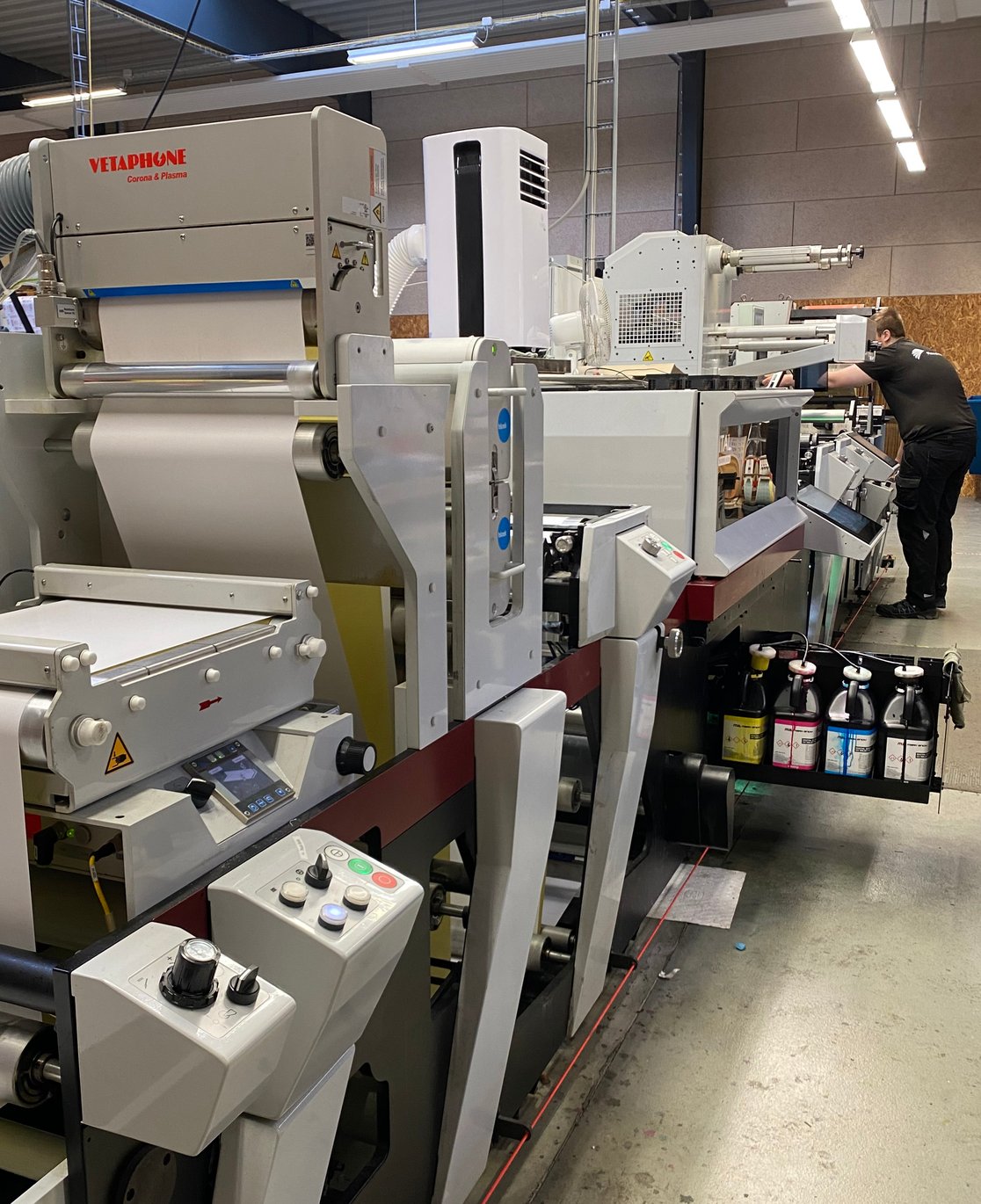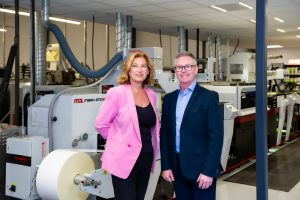Mark Andy Customers on The Rise and Rise of Hybrids
|
With the continued growth of digital print production in the narrow web sector, flexo press manufacturers have been keen to tap into markets where a combination of print technology offers converters something different. But only one company claims to offer a true hybrid solution that’s been developed in-house allowing it to come from a single source supplier. Nick Coombes speaks with Phil Baldwin, Sales Manager for Mark Andy in the UK & Ireland. NC: I guess the first thing we need to do is define what we mean by ‘hybrid’? PB: Across the market, the term hybrid is generally accepted to mean a combination of digital and analogue print technology, with inline converting capabilities. It was conceived as a means of offering the best of roll-to-roll digital print with additional flexo print and finishing units all on one platform for single pass production. NC: Was there much demand for this capability? PB: Initially it was more an exercise in what could be achieved technologically – like the very early days of commercial digital printing back in the 1990s, the technical capability preceded the market demand. It sounded like a good idea to combine the best of both worlds, but without an obvious and sizeable future demand, few manufacturers were willing to invest significant sums of money in the R&D required. NC: So how was the issue resolved? PB: Basically, by a flexo press manufacturer working in partnership with digital press manufacture to create a jointly branded hybrid solution with each adapting its own technology as required. There are many examples out there in the market that are well-known and much publicised, and gradually demand has picked up as new products have been developed that require a combined solution. But essentially you still have two different products from different manufacturers that were not co-developed and whose compatibility relies on adaptation and modification as opposed to a natural synergy. NC: Is your inference that Mark Andy saw things differently from the outset? PB: Yes, very differently. Right at the beginning we carried out some detailed market research on the likely demand for such technology and its performance parameters matched to production costs and potential sales volumes. What became clear to us was that to have the best chance of convincing flexo or digital printers to invest in hybrid technology we needed to develop it from the ground up in-house so that we understood every aspect and could ensure full compatibility between the various print and converting functions. NC: That sounds expensive and time-consuming… PB: It was enormously so, and I won’t pretend that there weren’t times when we doubted the worthiness of the effort and resources being expended. But we always believed in the value of the project and remained committed to a successful outcome. As one of the pioneers of narrow web technology we knew we had the depth of expertise needed to make it work, but it had to become a commercial product not just a practical embodiment of our technical skills – there’s a big difference between the two if you want to be profitable! NC: How has the market received Mark Andy’s Digital Series? PB: Initially with a degree of suspicion because it was an unknown and unproven concept. Flexo had been established and developed over many years and digital had been around for two decades, but a combination of the two posed questions of how it could be used by converters and marketed to their customers. But, once we were able to demonstrate its capabilities in terms of quality and flexibility, and faster running speed than a pure digital press, then its appeal became more obvious and those in the narrow web sector with an eye on the future began to see a new opportunity. One of the companies to pick up on what the Digital Series hybrid has to offer is long-time Mark Andy user, The Watershed Group, which is based in Ireland but also has production plants in Germany and Poland. Well-known for its creativity and high-quality labels for leading brand owners, the company invested in a Mark Andy Digital Series hybrid line back in 2018. I spoke with CEO Liz Waters about the company’s decision to go down this route and their experience in using hybrid technology in today’s highly competitive narrow web sector.
Liz Waters and Patrick Murphy say their Mark Andy Digital Series press in Dublin has opened new doors NC: Can you briefly outline your company’s background in narrow web technology? LW: The company was founded by my late husband back in 1992 and began with a single production facility in Dublin. As we grew it became obvious that we needed to rationalise our flexo capability and chose Mark Andy as our preferred manufacturer. In the intervening years we have installed close to 20 of their presses across the Group, which includes our subsidiary companies Etiko in Poland and Römer Etikett in Germany. NC: What was the thinking behind the choice of Mark Andy as your sole press supplier? LW: Building close strategic partnerships has always been key to our growth plan and we viewed Mark Andy’s experience in narrow web flexo as superior to other manufacturers. When they extended their expertise into designing and building their own digital/flexo hybrid it was a straightforward decision to stay with them. As with all new technology, the learning curve has had its issues for both parties, but the result has been worth the perseverance. NC: Where do you see hybrid technology fitting into the narrow web sector? LW: We have always had a good name for innovation, and the possibility of combining the quality of UV flexo with the flexibility of digital inkjet in a single pass operation gives us the power to differentiate our customers’ products from those of their competitors. The print quality is excellent, and we have the option to run the line as a flexo or digital press if we don’t need its hybrid capability – so we have the best of both worlds! NC: Did you consider installing a standalone digital press? LW: Yes, we did. We looked closely at what the leading toner and inkjet press manufacturers had to offer but felt that none of them offered anything special for our requirements. It was the combination of Mark Andy’s proven servo-driven flexo platform and its own integrated inkjet engine that set it apart. The extensive printing and converting capability in a single pass is ideal for our high-quality product portfolio of leading brands. The other bonus is that digital consumables like ink and toner, and the infamous click charge, can all be mitigated against by the hybrid’s combined flexo printing and inline finishing capability. NC: How do you see future investment in print technology at Watershed? LW: We love the quality that inkjet offers us for premium products that command premium prices, and the Mark Andy Digital Series has certainly opened new doors, but the hybrid concept is complex and the speed with which technology develops means that we will keep an open mind on which way we go from here. It’s important at Watershed that the technology we use is both innovative and commercial, and at the time a hybrid press fulfilled that brief. Another label converter to invest in a Mark Andy digital hybrid is Denmark’s FlexoPrint A/S based in Randers. One of the country’s leading narrow web flexo houses, FlexoPrint installed a Mark Andy Digital Series press in March 2018. It’s part of the rapidly expanding Optimum Group that now has manufacturing plants in Salzbergen and Greven, Germany, and I spoke with Managing Director, Lars Ole Nauta. NC: Why did you choose the hybrid route for your first digital press? LON: We have always been very proficient in narrow web flexo production and have a highly skilled labour force that yields excellent productivity on the type of labels we produce. One of the major benefits of flexo presses is the opportunity for single-pass production with added-value processes and die-cutting inline, so an inkjet hybrid was the best solution. NC: What has been your experience of the press in daily commercial operation? LON: In a word, ‘excellent’! It’s a 1st generation press so we had some issues initially, but these were resolved by the technicians at Mark Andy UK. It’s an easy press to learn and operate and gives us the single-pass production that we need – we especially like the possibility of laying down a flexo white before the digital engine and the fact that we can die cut inline. NC: What effect has it had on your business? LON: It’s exceeded our expectations and fits with our type of work very well. We’re not printing fine art here, we’re providing quality labels at competitive prices with very quick turnarounds to match the growing number of SKUs and declining run lengths. It’s a very commercial tool and by removing the need for a Repro Department, we can send 95% of jobs straight from the customer through our sales team to the press – we don’t need to offer any in-house adjustment to artwork, so it saves time and money. NC: What advice would you give to a label converter looking to invest in digital print technology for the first time? LON: In principle, I’d say you need to know your customers and their products and markets very well because the various types of digital presses available are suited to different types of work. Inkjet hybrid offers the flexibility and single-pass capability of a flexo/digital hybrid. For us, the Mark Andy Digital Series is a good fit and has been great value for money. NC:The overriding impression I get from discussing hybrid technology with manufacturer and users alike is that, while it’s not the answer to all label converters’ prayers, it is a highly proficient all-round production tool that offers an unmatched degree of flexibility and combines the best that flexo and inkjet technology provides in single-pass production. There are more Mark Andy hybrids in daily operation worldwide than any other brand – in fact possibly more than all other brands together. The message there, I believe, is that it’s a label printer’s press. |

FlexoPrint describes its Mark Andy Digital Series press as a ‘”very commercial tool and great value for money.” |
